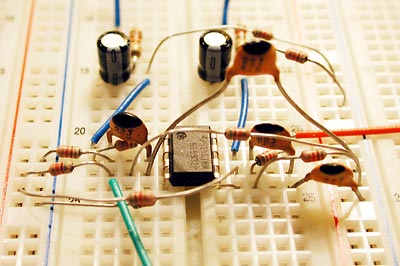Home > Studio Recording DIY Projects> Unbalanced to Balanced Line Converter
We did an unbalanced to balanced converter using dual opamp chips, the NE5532 opamp previously. While the previous circuit works, it uses a lot of components.... which means, more chances that something could go wrong.

Picture of old unbalanced to balanced converter
New Design
This new unbalanced to balanced converter uses a single chip and only 2 capacitors. We're using the Burr-Brown DRV134/135 chip. I got some DRV135 which comes in an SOIC package. There is a DRV134 which comes in an 8-pin DIP package.
I don't have the DRV134 so I had to improvise using my DRV135 so I can play with it on my breadboard. I carefully bent and soldered it's pins on an 8-pin IC socket. Then I check for any shorts before proceeding. Here is a picture of my SMD to 8-pin DIP converter.

A ballpoint pen is included in the picture so you can have an idea of the size. You need a steady hand, patience and a magnifying glass to do this operation. I'm glad to say that I didn't damage the DRV135 while doing this operation.
As you
can see from the datasheet, I just need two 10uF capacitors and
apply power to the chip. Voila! And we have a working unbalanced
to balanced converter. Cost of this converter chip is $4.39 which
is A LOT compared to the NE5532 which costs only $0.84. But I
think the simplicity of the implementation is well worth the
price.

The DRV135 has specs of 17Vrms into 600ohm load, distortion of .0005% at f=1Khz, high slew rate of 15V/us, and can operate at +/-18V.
This is also a companion to the INA134/137 balanced line receiver.
TESTING

This is a picture of the Melcor 1731 discrete opamp in an API preamp configuration design. For the outputs, I hooked up the DRV135, added the 2 capacitors and we're done. Next step is testing it!
TESTING
First, we apply a signal from our signal generator. The above waveform is the weak signal, and the signal below is the output of the discrete opamp preamp.

This is the output of the "TIP" signal from the DRV135 (pin 8). Notice the phase in relation to the input signal.

This is the output of the "RING" signal, pin 1. Notice the phase is 180-degree out of phase with the input.

What happens when we measure the output voltage across the TIP and RING?

Look at that! It doubled in size! Another way of saying it is, we just had a 6dB of gain converting an unbalanced to balanced signal.
Audio testing was also successful. Nice clean sound with no noise.